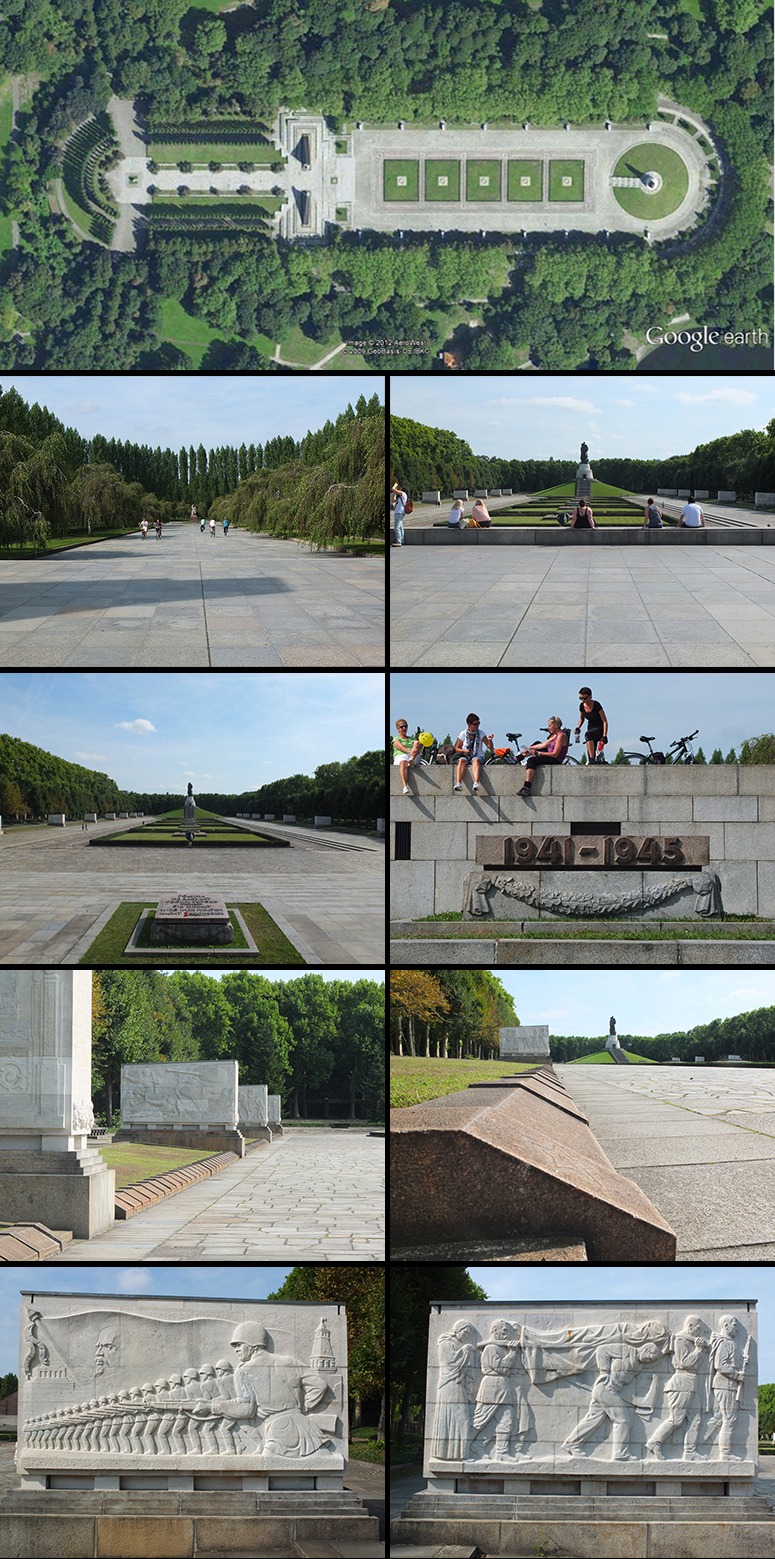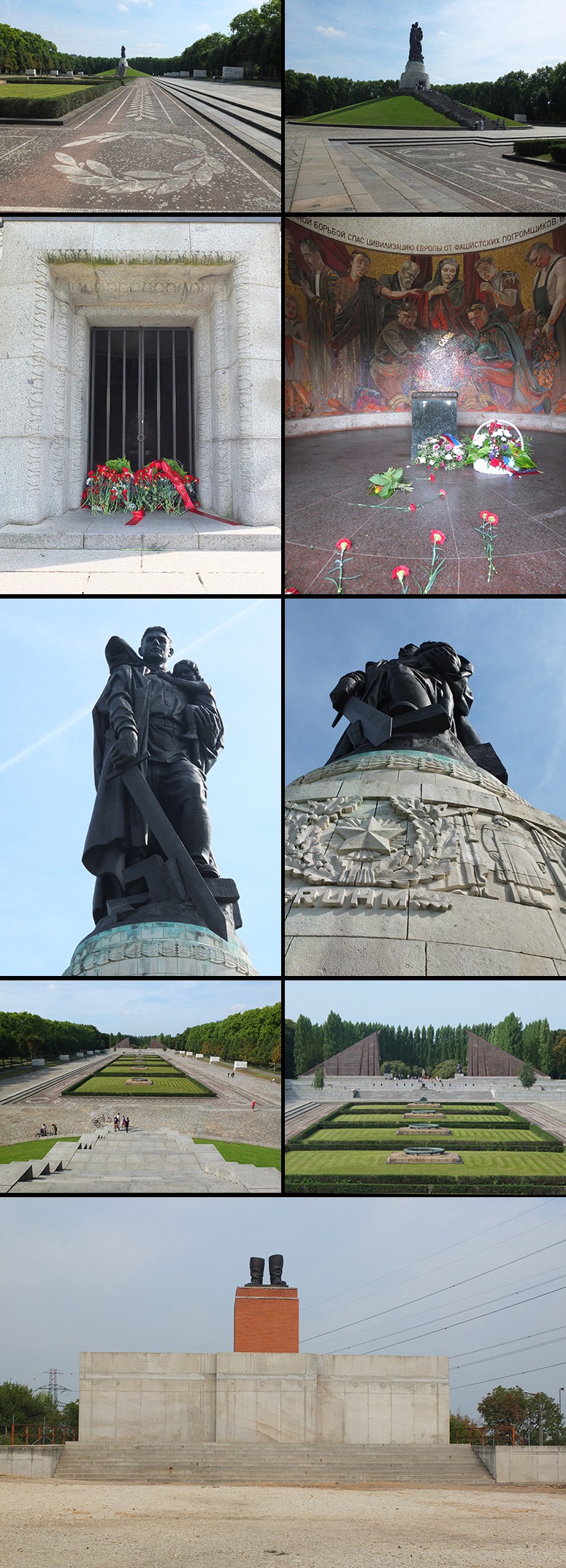Located in East Berlin, the Soviet Memorial in Treptower Park is the last resting place for 7,000 Russian soldiers. Planned in 1945, finished in 1949, the design was chosen in a competition to which 33 submissions were recorded. The winning design came from an artist’s collective that included the architect Yakov Belopolski, the sculpter Yevgeni Vuchetic, the painter Alexander Gorpenko and the engineer Sarra Valerius.The memorial was completely restored between 2003 and 2009, including the shipping of the 70 ton, 12 metre tall main statue – a Red Army soldier holding a child and standing over a shattered swastika – to the island of Rügen and back for repair. The memorial is ca. 570 metres long, 150 metres wide, and the main statue with its base mound stands 30 metres tall.
I am always very impressed with designs that rest heavily on trees for their main spatial definition. The Soviet Memorial relies on plane trees – now around 30 metres high – to define its outer boundary, with pleached limes – now around 15 metres high – used to step this scale down as an internal edge. There is an amazing avenue of weeping birches, now with crown diameters of up to 15 metres, planted at 25 metre centres. The western end of the axis is closed with lombardy poplars. One would look far today for a client that would be prepared to countenance a design that would first be ‘realised’ 40 years and more after its actual completion. As the point of the memorial is to convey everlasting glory upon the fallen soldiers, this aspect of the design makes it for me particularly moving.
The detailing of the memorial is superb. Students of landscape design should be encouraged to visit it to learn the importance of step, edge and paving details, and the enormous power of simplicity when ‘writ large’. It is a living memorial, fresh red carnations are strewn throughout on the statuary, and the room below the main statue is filled with flowers and garlands. There is a complete absence of religious symbolism.
Many people will not like this memorial, or this kind of political landscape. I was surprised myself that I found it very moving. Though most visitors were simply out enjoying the sun, one overheard many conversations on political themes, so it does seem that this piece of landscape design is still engendering debate.
The final image, included for contrast and to encourage comment, is taken in Budapest’s Memento Park, a collection of statuary from the Russian occupation of Hungary. The statue is of Stalin’s boots, all that remains of a massive sculpture of him that once stood in the centre of the city, after the population sawed off the rest of it and pulled it down.



Wow. Very moving design. The trees do add so much. It is impressive that decades had to pass before they grew enough that the memorial’s full majesty was realized. Great post.
From a political perspective the two Parks would seem to demonstrate that one man’s hero is another man’s villain.
However, from a landscape perspective the aesthetic achievement of the memorial in Treptower Park is evident for all to admire.
Are all the visual perspectives in Budapest’s Memento Park similarly bleak?
Lawrence, thank you for a wonderful set of photographs and accompanying commentary. I have not been there but agree that the Soviet Memorial in Treptower Park looks very moving. It also provokes some thoughts about dictators and design.
– Dictators, no matter when they live, are always likely to be attracted to what Europeans call the Baroque style
– It is hard to think of any style less in sympathy with the original principles of Karl Marx and Vladimir Ilyich Lenin – before they were corrupted into Marxist-Leninist political ideology
– Of all the mad things Hitler did, nothing beats his idiocy in the final days before Berlin fell to the Russians. Had he faced reality, the Cold War might never have happened.
– Like everyone else, landscape architects must regret that the evil Stalin ended the Modernist flowering of early Soviet art
– Yet there is undoubtedly a Modernist underlay, and overlay, to the Soviet Memorial in Treptower Park
– The Chinese seem to have missed this important aspect of Communist ideology, unless I am ill-informed
One has the impression that the city fathers of Budapest were very suspicious of the concept of a collection of Stalinist statuary. Memento Park is situated 10 kms from the city centre, the (young)owner of the cycle hire shop strongly advised me against attempting to cycle there: “…almost no one succeeds in finding it”, or, indeed, against going at all “…just a sea of mud with all those old statues standing around.”. When you finally do get there it is indeed a very bleak place, suffering now from a massive maintenance backlog, but worth the trip if, like me, you are fond of genteel decay and these kinds of political relics. It is now a commonplace in Berlin for city planners to complain that too much of the Berlin Wall was torn down too quickly – stretches of it have actually been rebuilt – and in the same way I think that items like “Stalin’s Boots” are powerful relics that do deserve preservation, and perhaps a more central location. But then, it wasn’t my country that was occupied for several decades by a foreign power…
There are plenty of internet images that can be googled, and some good things on Flickr.
A statuary park is a wonderful idea, and if the statutes are no longer in their original contexts but collected from all over the country, it is indeed fitting that their aesthetic situation is as bleak as the people’s experience of occupation.
“The park was designed by Hungarian architect, Ákos Eleőd, who won the competition announced by the Budapest General Assembly (Fővárosi Közgyűlés) in 1991.”
It would be wonderful to have an interpretitive element included so as to understand the various locations and histories behind the statuary collection and their presentation. The linking red brick wall is indeed a strange element?
Thankyou for the flickr reference: to an outsider they are wonderful!
[ http://www.flickr.com/photos/34664886@N04/3965908268/in/photostream/ ]
Christine, there were, apparently, guides stationed in Memento Park during its early years, there to fill in information as to who, why, where etc. My impression is that the number of visitors multiplied by the admission fee is nowhere near enough to carry this project, and there are no longer any guides. The park is not at all easy to get to, two trams and a bus are required, out into an anonymous urban fringe area dissected by motorway interchanges, where orientation is impossible for the casual visitor: perhaps too much trouble both for tourists and for locals.
My own reading is that the brick walls are intended to be ironic, neo-classical elements, thin like stage props, a reflection of the kind of architecture favoured both by the far left and the far right in modern European history. The main brick construction is the entrance area, housing ticketing and a small shop. I don´t think that the bleakness is a design element, more to do with an inadequate budget, both before and after completion.
There is an interesting multi-media exhibition outside the park. I watched a 1950´s training film for government agents, showing how to secretly film suspicious meetings in public places, and how to raid private apartments, both with and without ringing on the doorbell.
I like the idea of putting the statues in a forest instead of in a park. Hard to say why, but the the idea appeals to me.
The idea of the forest growing up and eventually obscuring the artefacts might appeal to both those Hungarians who detested the occupation and to those politicians who would prefer to forget their own involvement. I think, though, that Stalin´s boots should have been left on their original site, much in the way that fragments of the Berlin Wall still stand, and like the bomb-ruined relics of churches that serve as wordless war memorials in several major German cities.
Good points, so what about managing the ‘park’ as a forest? Europe could do with a greater forest extent.
As for what to do with Stalin’s Boots, I have several ideas (1) put them with Russia’s deposit of radioactive waste, when a means of safe storage has been agreed (2) keep them immersed forever in pigshit, if this could be arranged (3) see if anything can be learned from the disposal of another politicised priest: Osama Bin Laden.